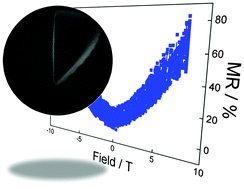CVD synthesis of carbon spheres using NiFe-LDHs as catalytic precursors: structural, electrochemical and magnetoresistive properties†
Abstract
The gram-scale synthesis of carbon spheres with a diameter of ca. 740 nm has been achieved by means of a chemical vapour deposition method using NiFe-layered double hydroxides as a solid catalytic precursor. The presence of the catalyst (FeNi3) allows controlling the final size distribution, resulting in a monodisperse sample. Their structural properties exhibited a high degree of graphitization according to their ID/IG ratio. In addition, their morphological features were unveiled by FIB-SEM and HRTEM, showing that they are formed by solid inner cores, and presenting labile chain-like structures due to accretion procedures. The solution and posterior sonication of the samples in toluene gave rise to the well-defined isolated spheres. The textural and electrochemical properties of the spheres have been tested showing non-mesoporous structures with a good behaviour as electrode materials for supercapacitors due to the presence of redox functionalities on their surface. Finally, magneto-transport measurements have been carried out, demonstrating semiconductor behaviour, as well as a positive magnetoresistance effect (ca. 72%) for the lowest studied temperature (2 K).


 Please wait while we load your content...
Please wait while we load your content...